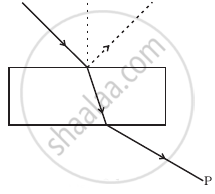Advertisements
Advertisements
प्रश्न
What is a Polaroid?
उत्तर
A Polaroid is a material which polarises light. The phenomenon of selective absorption is made use of in the construction of polariods. There are different types of polaroids.
A Polaroid consists of micro crystals of herapathite (an iodosulphate of quinine). Each crystal is a doubly refracting medium, which absorbs the ordinary ray and transmits only the extra ordinary ray. The modern polaroid consists of a large number of ultra microscopic crystals of herapathite embedded with their optic axes, parallel, in a matrix of nitro - cellulose.
Recently, new types of polariod are prepared in which thin film of polyvinyl alcohol is used. These are colourless crystals which transmit more light, and give better polarisation.
APPEARS IN
संबंधित प्रश्न
What dose a polaroid consist of?
A beam of unpolarised light is incident on a glass-air interface. Show, using a suitable ray diagram, that light reflected from the interface is totally polarised, when μ = tan iB, where μ is the refractive index of glass with respect to air and iB is the Brewster's angle.
Show, with the help of a diagram, how unpolarised sunlight gets polarised due to scattering.
Two polaroids P1 and P2 are placed with their pass axes perpendicular to each other. An unpolarised light of intensity Io is incident on P1. A third polaroid P3 is kept in between P1 and P2 such that its pass axis makes an angle of 45° with that of P1. Determine the intensity of light transmitted through P1, P2 and P3
Using the phenomenon of polarisation, show how the transverse nature of light can be demonstrated.
What is the Brewster angle for air to glass transition? (Refractive index of glass = 1.5)
Unpolarised light is passed through a polaroid P1. When this polarised beam passes through another polaroid P2 and if the pass axis of P2 makes angle θ with the pass axis of P1, then write the expression for the polarised beam passing through P2. Draw a plot showing the variation of intensity when θ varies from 0 to 2π.
What is the value of refractive index of a medium of polarising angle 60°?
State any two methods by which ordinary light can be polarised
Green light is incident at the polarising angle on a certain transparent medium. The angle of refraction is 30° . Find
(i) polarising angle, and
(ii) refractive index of the medium.
A ray of light is incident on a transparent medium at a polarizing angle. What is the angle between the reflected ray and the refracted ray?
Explain how an unpolarised light gets polarised when incident on the interface separating the two transparent media.
Light transmitted by Nicol prism is ______.
What is polarisation?
Discuss polarisation by selective absorption.
What is partially polarised light?
State Brewster’s law.
What is double refraction?
How is polarisation of light obtained by scattering of light?
What is normal focusing?
A plane mirror produces a magnification of
Consider a light beam incident from air to a glass slab at Brewster’s angle as shown in figure. A polaroid is placed in the path of the emergent ray at point P and rotated about an axis passing through the centre and perpendicular to the plane of the polaroid.

For the same objective, find the ratio of the least separation between two points to be distinguished by a microscope for light of 5000 Å and electrons accelerated through 100 V used as the illuminating substance.
To ensure almost 100 per cent transmissivity, photographic lenses are often coated with a thin layer of dielectric material. The refractive index of this material is intermediated between that of air and glass (which makes the optical element of the lens). A typically used dielectric film is MgF2 (n = 1.38). What should the thickness of the film be so that at the center of the visible spectrum (5500 Å) there is maximum transmission.
A polarizer - analyser set is adjusted such that the intensity of light coming out of the analyser is just 10% of the original intensity. Assuming that the polarizer - analyser set does not absorb any light, the angle by which the analyser need to be rotated further to reduce the output intensity to be zero, is ______.
